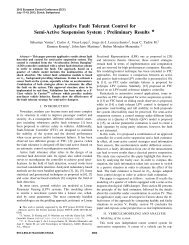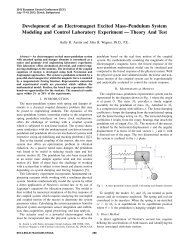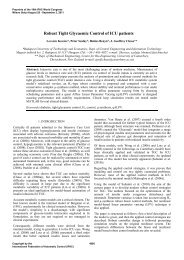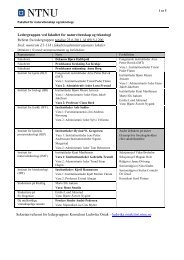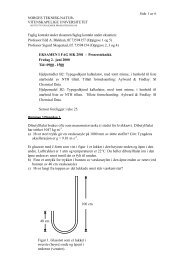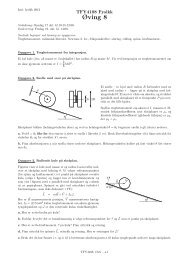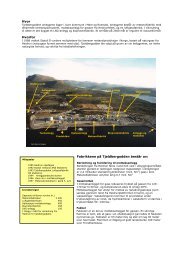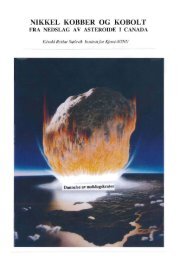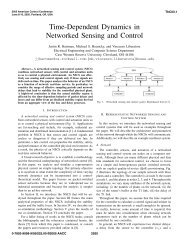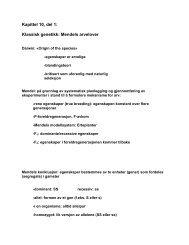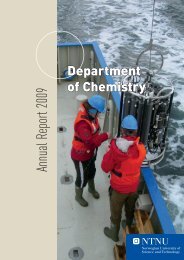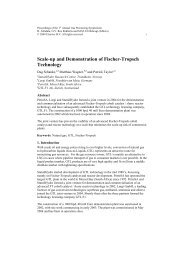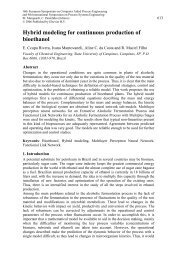CPC VI -- Chemical Process Control VI
CPC VI -- Chemical Process Control VI
CPC VI -- Chemical Process Control VI
Create successful ePaper yourself
Turn your PDF publications into a flip-book with our unique Google optimized e-Paper software.
Nonlinear Model Reduction for Optimization Based <strong>Control</strong> of Transient <strong>Chemical</strong> <strong>Process</strong>es 33<br />
triggered by the simulation or optimization algorithm<br />
or by an estimate of the error between the approximate<br />
local and the original models. Model parameters are obtained<br />
from some least-squares fit of data obtained from<br />
the original model. Various variants of updating schemes<br />
have been reported by Leesley and Heyen (1977), Macchietto<br />
et al. (1986), Hillestad et al. (1989) and by Storen<br />
and Hertzberg (1997). Obviously, parameter updates result<br />
in model discontinuities. If not properly handled,<br />
these discontinuities will make simulation and optimization<br />
algorithms fail or converge to wrong solutions (Barton<br />
et al., 1998). Hence, explicit discontinuity handling<br />
or discontinuity smoothing is a necessity with these models.<br />
For the latter approach, interpolation strategies employed<br />
in linear multiple models (e.g. Foss et al., 2000;<br />
Johansen and Foss, 1997)) could be adopted here.<br />
Significant savings in computational time have been<br />
reported for steady-state simulation and optimization<br />
(Chimowitz et al., 1984; Perregaard, 1993), dynamic<br />
simulation (Macchietto et al., 1986; Hager, 1992; Perregaard,<br />
1993; Ledent and Heyen, 1994) and dynamic<br />
optimization (Storen and Hertzberg, 1997) if local thermodynamic<br />
models are applied.<br />
Discussion<br />
Nonlinear model simplification has not yet got significant<br />
attention in the systems and control literature. It is particularly<br />
suited to simplify reduced order models arising<br />
from projection methods with the objective to regain at<br />
least to some extent sparsity in the reduced model Jacobian.<br />
There has been significant activity in the context<br />
of chemical kinetics and physical property models. The<br />
variety of techniques tailored to these special problems<br />
deserve careful analysis in order to assess the potential<br />
of applying the specific concept after generalization to<br />
other model simplification problems.<br />
For example, sensitivity analysis as worked out in<br />
chemical kinetics, is applicable in principle to the simplification<br />
of any parametric model (cf. the derivation by<br />
Seigneur et al., 1982) but—to the author’s knowledge—<br />
it has not been explored for general model simplification<br />
problems. This is also true for optimization based<br />
methods given the close correspondence between reaction<br />
model and general model simplification.<br />
On the other hand, the success of local physical property<br />
models suggests to consider similar strategies in a<br />
more general setting. The simplified model should be<br />
based on a fundamental principle rather than on some<br />
arbitrary empirical ansatz. In many cases, the simple<br />
models are only of sufficient accuracy in a limited region<br />
of the operating envelope. Then, adaptive updating of<br />
the parameters of a simple model structure using data<br />
from a rigorous model can be considered as an interesting<br />
alternative to globally valid simplified models. Obviously,<br />
a compromise needs to be established between<br />
model complexity and range of model validity. For exam-<br />
ple, a globally valid but complex neural network model<br />
(e.g. Kan and Lee (1996) for a liquid-liquid equilibrium<br />
model or Molga and Cherbański (1999) for a liquid-liquid<br />
reaction model) can be used instead of a simpler (local)<br />
model with a limited region of validity which requires<br />
parameter updating along the trajectory.<br />
There is an obvious relation between model simplification<br />
and hybrid models as discussed above. Hybrid<br />
models are motivated by a lack of knowledge on the<br />
mechanistic details of some physico-chemical phenomena.<br />
A nonlinear regression model such as a neural network<br />
is used instead of a fundamental model to predict<br />
some process quantity (such as a reaction rate, a<br />
mass transfer rate or phase equilibrium concentrations).<br />
Model simplification on the other hand aims at reducing<br />
the complexity of a given fundamental model. Hence,<br />
hybrid modeling in the sense of Psichogios and Ungar<br />
(1992) can be readily applied to model simplification.<br />
The (typically algebraic) mechanistic model, which—for<br />
example—determines a flux (e.g. a reaction rate, see<br />
Molga and Cherbański, 1999), or a separation product<br />
flow rate, (see Safavi et al., 1999), a kinetic coefficient<br />
(e.g. a flotation rate constant, see Gupta et al., 1999),<br />
some state function (e.g. a holdup in a two-phase system,<br />
see Gupta et al., 1999) is replaced by some nonlinear<br />
regression model (such as a neural network). This<br />
regression model is typically explicit in the quantity of<br />
interest and hence can be evaluated extremely efficiently.<br />
Note, that these models can be designed for a large or<br />
a small region of validity. In the latter case, parameter<br />
updating (using the rigorous model to produce the data<br />
required) is required along the trajectory.<br />
Model Application<br />
We assume that a detailed dynamic model is available<br />
for example from the process design activities. This<br />
model can be simplified or reduced by physical insight,<br />
by one of the techniques discussed above, or by a combination<br />
thereof to meet the requirement of the various<br />
model-based tasks in integrated dynamic optimization<br />
and control system following a direct or some decomposition<br />
approach. This section summarizes some<br />
thoughts about the type of reduced and/or simplified<br />
models which might be used most appropriately in a certain<br />
context.<br />
Direct Approach<br />
We can make use of any model and apply an optimizing<br />
predictive control and a suitable reconciliation scheme<br />
to realize dynamic real-time optimization by the direct<br />
approach. Instead of following a reference trajectory set<br />
by some upper decision layer in the control hierarchy, an<br />
economical objective is maximized on-line on the receding<br />
control horizon to compute the control moves. The<br />
computational complexity of the reconciliation and con-



